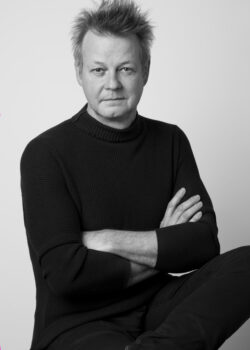Profiles

Jeremy Edminston
This is one of a series of interviews with the Graduate Program Spitzer’s new program directors conducted by Erica Wszolek, executive associate to the dean and communications manager, during summer 2020.
Associate Professor Jeremy Edmiston directs the Master of Architecture program and is principal at SYSTEMarchitects. His focus on complex geometry in architecture produces striking design, and he is also a leader in digital technology to construct prefab structures. These technological advances are especially relevant to contemporary cities, another focus of Edmiston, whose projects in the urban landscape range from urban farming and homelessness to reducing the environmental load of high-rise buildings and creating contemporary design in the context of historic neighborhoods.
Why did you choose to work at Spitzer?
It’s the best job in the city. As an architect you’re really curious about how the city works, how it operates, what the different layers of the city are. I don’t how I would meet the people that I meet at City [College] if I didn’t work at City. I mean, how would I ever understand or rub shoulders with our students and our faculty in any other context? So, I think it’s an incredibly privileged position, and it occupies a very particular place within the city. It’s unique. I think that’s one reason why it’s one of the best jobs in the city. The other thing is that it’s part of the city’s infrastructure, for better or worse. At the moment it’s a little worse, right? The National Guard can take over City College in a way that they can’t take over Columbia University. The governor can cut the budget of City College in a way that they can’t [for private schools] . . . so you’re part of the life of the city, you’re part of the energy of the politics and the governance of the city. And architecture is about understanding the space of the city, and you need to understand the structures that create that space, and City is just a remarkable place to do that.
What ambitions do you bring to the post of program director?
I think I want what everybody wants, and that is for the program to be relevant. I want the program to be relevant for our students, relevant for the city, relevant for the culture of architecture. I’d like the program to contribute to the discussion of what making the built environment is. I’d like us to be able to contribute to the making of that built environment as well as the discussion of what it is and what it needs to be. I think that’s the basic ambition for architecture, for art. We make because we want to be relevant. We speak the language of making, and at the school — in the context of college — “making” is the making of ideas and the making of discussion as much as the making of propositions, the making of speculations. We make these stories. We make these fantastic visions. This is the language we speak. We make these essays. We make these ideas in all kinds of ways, and the reason why we make them is that we want our voices heard, we want to be relevant, and we want to be a part of the discussion, so that’s my ambition for us and for the school.
What insights from your teaching and professional experience are you hoping to integrate or adopt as a program director?
Curiosity, right? We have to learn together. I don’t know what the future is. What the hell is the future? But I know that curiosity will help us. I have practiced the discipline of architecture, and I know that that allows us to see around corners. It allows us to see through things. In the practice and the discipline of architecture, we are scientists and artists. We believe in the human experience and the possibility of humanity. That’s architecture, right, so I bring that. Beyond that, we’re in this together.
In one word, what do you hope your legacy to be?
Jesus, I’m starting this thing and you’re asking about my end already? Red is coming that soon? Thanks Lesley. . . . Fun!
Fun?
Yeah, we need more levity. We need more fun. If it’s not fun, why are we doing it?

